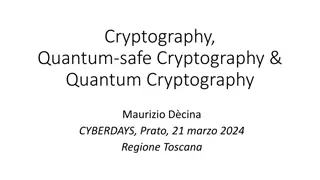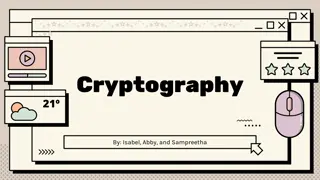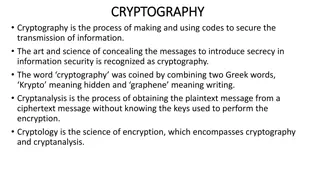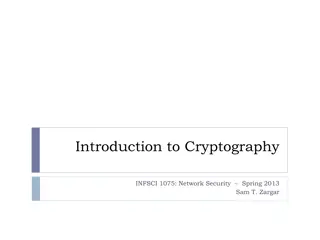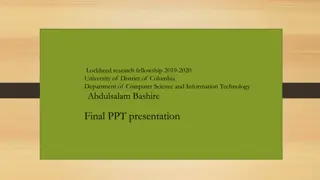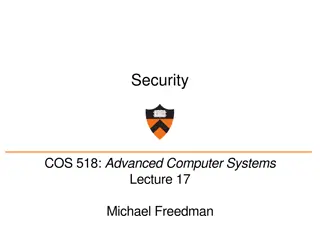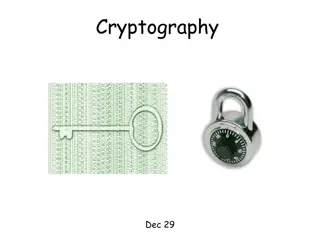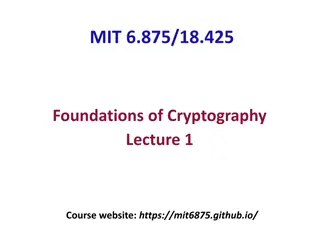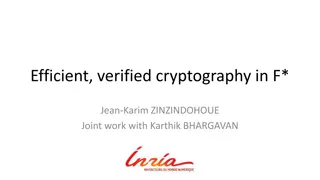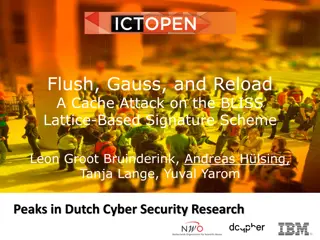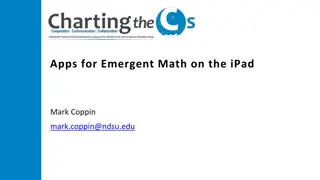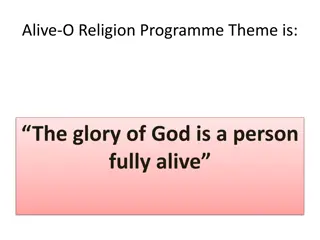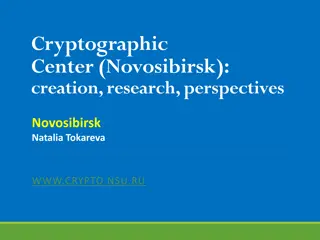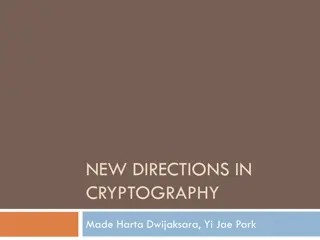MAT199: Math Alive Cryptography - Why We Need It
Cryptography is essential for secure information transfer in various aspects of modern life, from online purchases to transmitting TV signals. However, the importance of safeguarding information against external threats cannot be overstated, as seen in examples like intercepting private messages and obtaining credit card details. Explore the significance and practical applications of cryptography in maintaining data security and privacy.
Download Presentation

Please find below an Image/Link to download the presentation.
The content on the website is provided AS IS for your information and personal use only. It may not be sold, licensed, or shared on other websites without obtaining consent from the author.If you encounter any issues during the download, it is possible that the publisher has removed the file from their server.
You are allowed to download the files provided on this website for personal or commercial use, subject to the condition that they are used lawfully. All files are the property of their respective owners.
The content on the website is provided AS IS for your information and personal use only. It may not be sold, licensed, or shared on other websites without obtaining consent from the author.
E N D
Presentation Transcript
Welcome back! It s spring or supposed to be
MAT199: Math Alive Cryptography Ian Griffiths Mathematical Institute, University of Oxford, Department of Mathematics, Princeton University
Cryptography: What is it and why do we need it? The need to transfer important information in a secure way is vital, e.g., Purchasing goods on the internet
Cryptography: What is it and why do we need it? The need to transfer important information in a secure way is vital, e.g., Purchasing goods on the internet Transmitting private messages
Cryptography: What is it and why do we need it? The need to transfer important information in a secure way is vital, e.g., Purchasing goods on the internet Transmitting private messages Communicating strategies to allies in a war
Cryptography: What is it and why do we need it? The need to transfer important information in a secure way is vital, e.g., Purchasing goods on the internet Transmitting private messages Communicating strategies to allies in a war Transmitting TV signals to subscribers
Cryptography: What is it and why do we need it? However, the ability for external parties to access this important information is just as desirable (if not more so), e.g., obtaining credit card details
Cryptography: What is it and why do we need it? However, the ability for external parties to access this important information is just as desirable (if not more so), e.g., obtaining credit card details intercepting private messages
Cryptography: What is it and why do we need it? However, the ability for external parties to access this important information is just as desirable (if not more so), e.g., obtaining credit card details intercepting private messages having an advantage over enemies in war
Cryptography: What is it and why do we need it? However, the ability for external parties to access this important information is just as desirable (if not more so), e.g., obtaining credit card details intercepting private messages having an advantage over enemies in war accessing TV stations without subscribing
How can information be transmitted securely? How can we transfer some information from one place to another without an intermediate observer being able to read the information?
Simple coding strategies An ancient way of encrypting a message used by the Chinese was to wrap paper around a cane with a particular size and write the message. When the paper is unwrapped from the cane the message is encrypted and can only be understood when wrapped around a cane with the same diameter.
Simple coding strategies Transliteration schemes and substitution ciphers
Simple coding strategies Transliteration schemes and substitution ciphers Another simple way of coding a message is to replace each letter with another random one: To decode the message we just work in the opposite direction.
Simple coding strategies Transliteration schemes and substitution ciphers You can use simple transliterations that involve just a shift in the alphabet: These are called Caesar codes.
Simple coding strategies Transliteration schemes and substitution ciphers You can use simple transliterations that involve just a shift in the alphabet: These are called Caesar codes. Or you can make a shift and reflect the alphabet: In these cases the recipient only needs to know the number of places that we have shifted and whether there is a reflection, rather than a complete code that tells us which letter corresponds to which coded letter.
Simple coding strategies Transliteration schemes and substitution ciphers These kinds of codes can be fairly easily deciphered. How?
Simple coding strategies Transliteration schemes and substitution ciphers These kinds of codes can be fairly easily deciphered. How? By working out the frequency of the occurrence of each letter we can decode a message.
A more sophisticated scheme How can we transmit a password, e.g., to enable subscribers of a TV network provider to view their channels, without other people intercepting this?
A more sophisticated scheme How can we transmit a password, e.g., to enable subscribers of a TV network provider to view their channels, without other people intercepting this? Digital information is encoded itself in binary we use this to create a password and a key structure.
A more sophisticated scheme How can we transmit a password, e.g., to enable subscribers of a TV network provider to view their channels, without other people intercepting this? Digital information is encoded itself in binary we use this to create a password and a key structure. The solution is to use a password and a key. Each subscriber has a separate key. The service provider sends out a series of codes, each of which contains the password to unlock the channels when combined with the key of a given individual is used.
A more sophisticated scheme A TV service provider will send out many of these codes (for all of the subscribers). The user s box will then filter through all of these codes, applying their key, until the screen becomes clear.
A more sophisticated scheme A TV service provider will send out many of these codes (for all of the subscribers). The user s box will then filter through all of these codes, applying their key, until the screen becomes clear. For an interceptor it is very difficult to extract the password from the codes that are sent out.
Cryptography: Summary of lecture 13 How can we transmit information secretly across a public network?
Cryptography: Summary of lecture 13 How can we transmit information secretly across a public network? Transmitting information openly clearly doesn t work.
Cryptography: Summary of lecture 13 How can we transmit information secretly across a public network? Transmitting information openly clearly doesn t work. I haven t showered in five days
Cryptography: Summary of lecture 13 How can we transmit information secretly across a public network? Transmitting information openly clearly doesn t work. I haven t showered in five days If we send a key separately to the receiver and then a locked message this works
Cryptography: Summary of lecture 13 How can we transmit information secretly across a public network? Transmitting information openly clearly doesn t work. I haven t showered in five days If we send a key separately to the receiver and then a locked message this works provided the interceptor doesn t make a copy of the key.
Cryptography: Summary of lecture 13 How can we transmit information secretly across a public network? Transmitting information openly clearly doesn t work. I haven t showered in five days If we send a key separately to the receiver and then a locked message this works provided the interceptor doesn t make a copy of the key. If we send a box with an open padlock in that we have the key to, then the receiver can write the message, place in the box and lock. Only we can open the box. This works (I still don t know what Isabel wrote in her message) but how does this translate to sending information across the internet?
Cryptography: Summary of lecture 13 How can we transmit information secretly across a public network? Transmitting information openly clearly doesn t work. I haven t showered in five days If we send a key separately to the receiver and then a locked message this works provided the interceptor doesn t make a copy of the key. If we send a box with an open padlock in that we have the key to, then the receiver can write the message, place in the box and lock. Only we can open the box. This works (I still don t know what Isabel wrote in her message) but how does this translate to sending information across the internet?
Cryptography: Summary of lecture 13 We are looking for a way to communicate information (e.g., a number) from one place to another in a public way such that only the receiver can decode this. To do this we need some mathematical tools. The first of these is modular arithmetic.
Cryptography: Summary of lecture 13 We are looking for a way to communicate information (e.g., a number) from one place to another in a public way such that only the receiver can decode this. To do this we need some mathematical tools. The first of these is modular arithmetic. Question: When we divide 78125 by 7 what is the remainder?
Fermats last theorem And this proposition is generally true for all progressions and for all prime numbers; the proof of which I would send to you, if I were not afraid to be too long. Pierre de Fermat 1601 1665
Andrew Wiles The Andrew Wiles Building, Mathematical Institute, University of Oxford
Some announcements Feng Zhu s office hour next week will be from 11-midday on Friday in the Common Room (instead of 4-5pm on Monday).
Some announcements Feng Zhu s office hour next week will be from 11-midday on Friday in the Common Room (instead of 4-5pm on Monday). Heather Macbeth will not be giving an office hour this week (normally Wednesdays 2 3pm).
Summary of lecture 14 We are looking for a way to communicate information (e.g., a number) from one place to another in a public way such that only the receiver can decode this.
Summary of lecture 14 There are three useful properties of modular arithmetic. Property 1
Summary of lecture 14 There are three useful properties of modular arithmetic. Property 1 If and then Property 2 Property 3 Property 3 is useful in calculating the remainder for very large numbers and is a crucial ingredient in cryptography.
Euclid The date and place of Euclid's birth and the date and circumstances of his death are unknown.
Midterm Essays If you wrote your essay on mathematics relating to nature or art then these have not yet been graded by the grader assigned to these They should hopefully be done by the end of today! On each of the midterm essays I have tried to include a way of improving your grade even further for next time.
Summary of lecture 15 We are looking for a way to communicate information (e.g., a number) from one place to another in a public way such that only the receiver can decode this. To do this we need modular arithmetic and the Euclidean algorithm. Today: we will see how this all fits together. We will also do some magic
Summary of lecture 15 We are looking for a way to communicate information (e.g., a number) from one place to another in a public way such that only the receiver can decode this. To do this we need modular arithmetic and the Euclidean algorithm. Today: we will see how this all fits together. We will also do some magic


